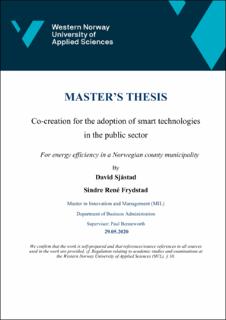| dc.description.abstract | Facing an ongoing climate crisis has resulted in world organizations’ having devotedly allocated enormous resources to facilitate a global energy transition. This creates a dispersion for sustainability and energy efficiency, on local and regional levels as well. Rapid growing technological development lead to great opportunities for businesses across sectors. However, it exists a deployment failure of smart technologies in the public sector, whereof it is suggested that certain barriers are preventing the public sector to innovate and to adopt smarttechnologies to exploit the technological benefits towards energy efficiency.
Focusing on public buildings in Vestland county municipality, the purpose of this study is to explore the barriers preventing the public sector adopting smart-technologies for energy efficiency, and how the barriers can be solved by utilizing co-creation. The current climate plan highlights that the greatest potential, as well as challenges, for energy efficiency lies within the existing building mass. Since upper secondary schools are under the ownership of
Vestland county municipality, and makes up 95% of the building mass that, we have focused our case towards these buildings. We have limited our research geographically by addressing upper secondary schools located in Bergen municipality. By conducting a qualitative single case study, framing public buildings (upper secondary schools) in
Bergen, we have collected data material from actors from the private and public sectors, as well as academia. In addition, we completed a pilot study through the fall semester in 2019, with the intention to create knowledge before the actual research started. We also participated relevant seminars and observed speakers presenting ongoing challenges and opportunities related to energy efficiency in buildings. Combined with secondary data, we have uncovered knowledge that has given us insights on barriers relating to the adoption of smart technology, and how these can be solved utilizing co-creation. Through a comprehensive analysis process, we a total of 20 barriers are prominent in the following categories: prioritization, organization, economy, expertise, technology and regulations. We also describe recommendations for the co-creation process, as well as conditions that must be in place for co-creation to effectively solve the barriers. The results of the analysis suggest that co-creation can solve 16 of 20 barriers, and thus could greatly contribute for overcoming the barriers that are preventing the adoption of smart technology in the public sector. We have enriched the theoretical framework with empirical findings through comparison of the two frameworks. The study concludes with lack of priority as the strongest contribution to established knowledge about barriers to innovation in the public sector. | en_US |

